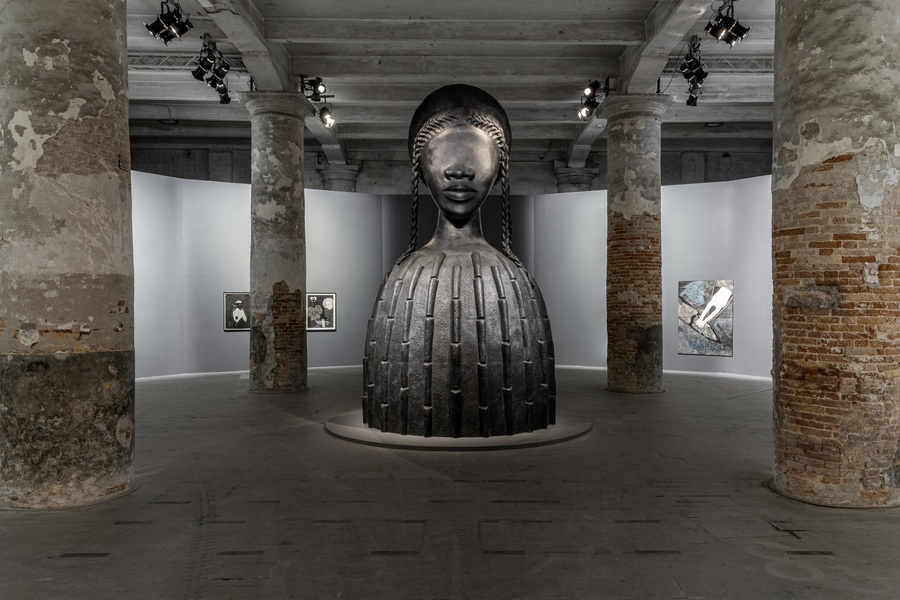Sonia Boyce, Alberta Whittle, Simone Leigh at the Venice Biennale
This year’s Venice Biennale sees Black women of Caribbean descent representing Scotland, Britain and the United States – this is why this rendition of the Biennale is so important
It may seem an odd comparison to make, but there are some commonalities between the islands of the Venetian lagoon and the islands of the Caribbean. Both archipelagos are creolised spaces, with histories that are entangled with migration, colonialism and the trade in enslaved people from Sub-Saharan Africa. It is widely believed that Venice itself was founded by refugees fleeing an invasion of mainland Italy nearly 2000 years ago, but now a new wave of refugees, many from Sub-Saharan Africa, find themselves on the margins of the floating city. In 2017, a Gambian man drowned in the Grand Canal in front of hundreds of onlookers, who, instead of helping him, shouted racist abuse.
Alberta Whittle, representing Scotland at the Venice Biennale this year, examines Venice’s complicated relationship with Blackness. One scene of her film, Lagareh – The Last Born, features statues of enslaved Black people that can be seen in the Santa Maria Gloriosa dei Frari Church in the city. The statues, with torn clothing and tortured expressions, are an apt reminder of how Venice is inevitably tied up in European histories of slavery and colonialism. Whittle’s film exceeds simply just displaying Venetian representations of Black people but instead creates the possibility for their liberation. The film is dedicated to Sheku Bayoh, who died in police custody in Kirkcaldy in 2015, which made it tragically evident that police brutality is an issue that Scotland is not immune from. Footage shot at Bunce Island, (an island off the coast of Sierra Leone where tens of thousands of enslaved people were held and then shipped to the Americas) which was administered by two Scottish men for several decades in the 18th century, attests to Scotland’s involvement in the transatlantic slave trade.
Sonia Boyce is exhibiting at the British Pavilion, a long-overdue recognition of an artist who has been creating multi-faceted and discipline-defying work since the early 1980s. Boyce's commission Feeling Her Way brings together video works featuring five musicians of colour, as well as sculptural and wall-based installations. This new work expands on the artist’s Devotional Collection, which spans three centuries and honours Black British female musicians and their contribution to diasporic culture. Boyce has always been concerned with the ability of the archive to speak for the absences in Britain’s social and cultural history.
Meanwhile, Simone Leigh is exhibiting in the American Pavilion, where her monumental sculptures fill the stately building. Titled Sovereignty, her works bridge transatlantic artistic traditions from Africa, Europe and the USA to create hybrid forms that the American scholar Saidiya Hartman describes as "an architecture of possibility." Leigh also examines ideas of exploitation and mimicry; the low hanging thatch she has installed around the exterior of the building references a structure that was displayed at the 1931 Paris Colonial Exposition, where people from France’s colonies were put ‘on display’ alongside architectural replicas of their domestic spaces.
On top of their radical commitment to surfacing and archiving transatlantic histories and their connections to the Caribbean, what binds the work of Whittle, Boyce and Leigh together is a celebration of community. As part of her commission for the American Pavilion, Leigh is co-programming Loophole of Retreat: Venice with Rashida Bumbray, a convening of Black women scholars and creatives in October this year. This communion is a method of extending the temporality of important conversations beyond the Biennale, within the context of an art world that still views Black artists as a trend. Sonia Boyce’s exhibition platforms five musicians of colour, while Alberta Whittle’s commission continues her collaborative practice with a variety of collaborators whom she calls ‘accomplices’.
The 55th International Venice Biennale runs until 27 Nov


